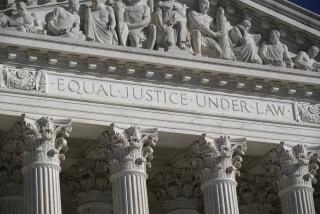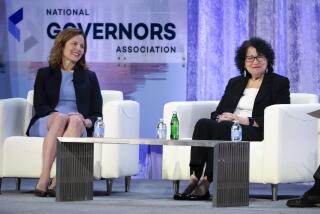SCOTUS on YouTube: Now, how about real cameras?

Surreptitiously recorded videos of Supreme Court proceedings that surfaced on YouTube last week aren’t much of a viewing experience. The most revealing video, which captures a few moments from two oral argument sessions, is a jerky affair that makes Abraham Zapruder’s amateur footage of the Kennedy assassination look like the work of an auteur.
And the justices are bit players: The star of the video is Noah Kai Newkirk, a Los Angeles man who stood up during arguments Wednesday to denounce the court’s 2010 Citizens United decision allowing corporations to spend money on politics.
Yet, despite its intrinsic lack of interest, the video has created a frisson among court watchers and in the general public because it represents a flouting of a Washington taboo: the court’s ban on TV cameras.
But the proper lesson to draw isn’t that the court should be more assiduous in keeping spectators from smuggling video-equipped cellphones into the building; it’s that the court’s public proceedings should be regularly and professionally televised, as those in Congress have been for decades.
Members of the court have offered several reasons for the no-cameras rule, all of them specious. Justice Clarence Thomas has suggested that televising oral arguments might deprive some justices of their anonymity and make them prey for terrorists. Justice Anthony M. Kennedy has expressed concern that if cameras were present, a justice might say something “for a soundbite.” Most recently, Justice Ruth Bader Ginsburg suggested that televising arguments would “leave a false impression … that the oral argument is what is decisive in the cases.”
You don’t have to be an experienced legal advocate to refute these arguments. Terrorists who might want to attack Supreme Court justices already know what they look like. Soundbites of justices’ comments can already be snipped from the audio recordings of arguments that are posted on the court’s website; some of these have been recycled on news broadcasts (such as Justice Antonin Scalia’s comparison of a health insurance mandate to a law requiring people to buy broccoli). And if televising arguments deludes people into thinking that the justices don’t also consider written briefs, the same can be said for making the arguments available in audio form.
We suspect the real explanation for the justices’ camera-shyness is institutional inertia, combined with a snobbish assumption that the court isn’t like those vulgar political branches. Neither attitude is defensible. The public shouldn’t have to rely on bootleggers or protesters to catch a glimpse of the public proceedings of an important part of their government. Cue the cameras.
More to Read
Start your day right
Sign up for Essential California for news, features and recommendations from the L.A. Times and beyond in your inbox six days a week.
You may occasionally receive promotional content from the Los Angeles Times.






